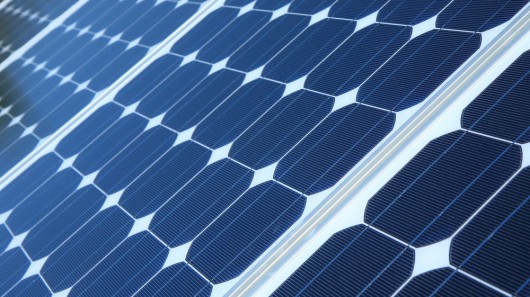New nanocrystals let solar panels generate electricity ... and hydrogen gas
By David Szondy
August 28, 2012

Scientists have developed new nanocrystals that allow solar panels to generate both electricity and hydrogen gas (Photo: Shutterstock)
At first glance, photovoltaic solar panels are brilliant. They’re self-contained, need no fuel and so long as the sun is shining, they make lots of lovely electricity. The trouble is, they’re expensive to make, batteries are poor storage systems for cloudy days, and the panels have a very short service life. Now, Dr. Mikhail Zamkov of Ohio's Bowling Green State University and his team have used synthetic nanocrystals to make solar panels more durable as well as capable of producing hydrogen gas.
Solar panels using inorganic molecules as part of their construction have a short service life. The effects of UV radiation and heat degrade them, and they end up with a life of only about 20 years. Given how expensive it is to make solar panels, it’s not surprising that the cost per kilowatt is so much higher than conventional energy sources. In a video paper published in the Journal of Visualized Experiments (JoVE), Zamkov outlines his team’s process that involves replacing the organic molecules with two inorganic nanocrystals made from zinc selenide and cadmium sulfide, with a platinum catalyst added.
Structure of the nanocrystal (Image: Bowling Green State University)
According to Zamkov, "The main advantage of this technique is that it allows for direct, all inorganic coupling of the light absorber and the catalyst." In other words, these are very durable crystals compared to their organic counterparts. Not only are they less susceptible to heat and UV radiation, they also don’t suffer from degradation problems that plague their organic counterparts – where those are often irreversibly “poisoned” while in service, the nanocrystals can be recharged with a methanol wash.
The other advantage is that the nanocrystals don’t just generate electricity, they produce hydrogen gas as well. When immersed in water and exposed to light, the rod-shaped cadmium sulfide nanocrystal breaks down the water into hydrogen and oxygen.
Meanwhile, the nanocrystal – that is composed of stacked layers of zinc selenide – is photovoltaic and generates electricity. With this dual capacity, a panel made with the nanocrystals would not only generate power during the day, but also hydrogen to run a fuel cell at night.
Source: Journal of Visualized Experiments
 David Szondy
is a freelance writer based in Monroe, Washington. An award-winning
playwright, he has contributed to Charged and iQ magazine and is the
author of the website Tales of Future Past.
David Szondy
is a freelance writer based in Monroe, Washington. An award-winning
playwright, he has contributed to Charged and iQ magazine and is the
author of the website Tales of Future Past.
Copyright © gizmag 2003 - 2012 To subscribe or visit go to: http://www.gizmag.com
